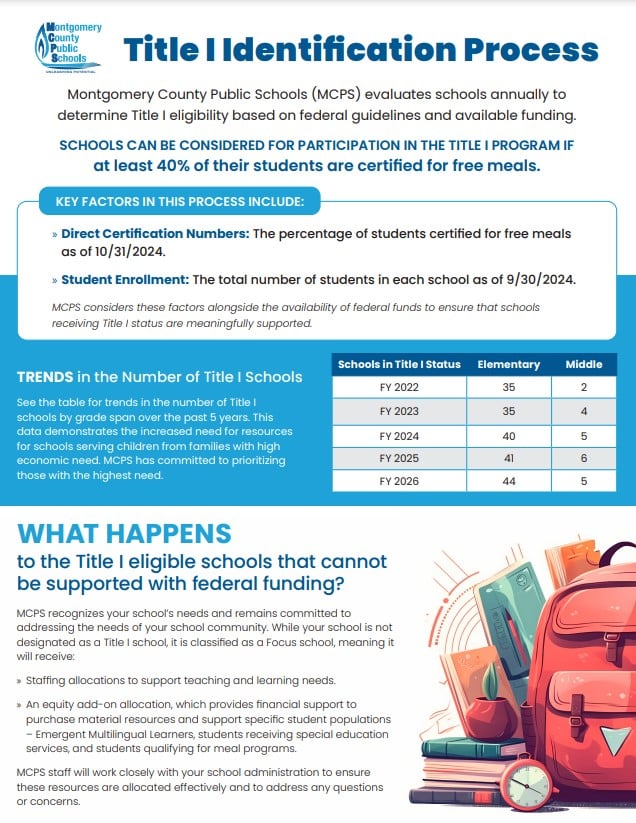How Schools are Identified for Title I
What Is Title I?
Title I is a federal program that provides additional funding to schools, enabling them to better support students from families living in communities with greater economic needs.
How Title I Eligibility Is Determined:
Each year, Montgomery County Public Schools (MCPS) identifies Title I schools based on federal guidelines and available funding. Federal guidelines state that schools with 40% or more of their students certified for free school meals meet the criteria to be considered for participation in the Title I program.
Meeting the criteria to be considered for participation in the Title I program does not mean that schools will participate in the Title I program.
After determining which schools can be meaningfully supported based on the total funding received, MCPS identifies which schools will participate in the Title I program. The total amount of funding MCPS receives for Title I changes every year.
For the school year 2025-2026, a school must also meet MCPS’ threshold, which is 43.80 percent for elementary and 42.90 percent for middle schools.
Click here to see how the schools are listed in rank order:
What data is used to determine Title I eligibility?
- Direct Certification Numbers: The percentage of students certified for free meals as of October 31, 2024.
- Student Enrollment: The total number of students in each school as of September 30, 2024.
The number of students directly certified is divided by the student enrollment to determine the percentage of students directly certified for free meals. This measure is used for both schools who operate under the Community Eligibility Provision and those who do not.
Q&A
What does Direct Certification mean?
Direct certification means that students automatically qualify for free school meals based on their household’s participation in the other programs such as Supplemental Nutrition Assistance Program (SNAP), Temporary Assistance for Needy Families (TANF), Head Start Free, Medicaid Free, or students are identified as Foster Free, Homeless, Migrant, or Runaway.
How are Title I schools selected?
To identify Title I schools, all schools are put in order from highest to lowest based on the percentage of students certified for free school meals. Schools with 40% or more of their students certified for free school meals meet the criteria to be considered for participation in the Title I program. After determining which schools can be meaningfully supported based on the total federal funding received, MCPS identifies which schools will participate in the Title I program. The total amount of funding MCPS receives for Title I changes every year.
What additional supports are provided to Title I schools?
Title I schools received federal funds to support student academic achievement. These funds support critical initiatives that help our children and school communities thrive, including:
- Hiring more teachers and staff to reduce class sizes and provide individualized attention.
- Purchasing additional educational materials to support learning and growth.
- Creating innovative programs and resources tailored to meet the needs of students.
Do schools have to qualify for Title I status each year?
Yes, identification of Title I schools is an annual process.
What happens if a school loses its Title I status?
MCPS is committed to providing continued support to the school community by designating it a Focus School.
What is a Focus School?
Title I schools have the highest percentage of children certified to receive free meals. Similarly, Focus schools also have high percentages of children certified to receive free meals, though these percentages are slightly lower than in Title I schools.
As a focus school, for school year 2025-2026, focus schools will receive the following:
- additional staff to help meet teaching and learning needs;
- Equity Add-On Funding to support students learning English (Emergent Multilingual Learners), students receiving special education services, and students eligible for free or reduced-price meals; and
- Reduced class sizes.
What happens if a school has a regional program that draws students from outside of the attendance zone?
When calculating direct certification and enrollment, all enrolled students are counted. This includes enrolled students, whether it is their home school or not.
Additional Title I Resources
- Title I At-A-Glance (hyperlink in this document): https://all4ed.org/wp-content/uploads/2023/01/Title-I-At-A-Glance.pdf
- Community Eligibility Provision and Title I Intersection (hyperlink in this document):
https://frac.org/wp-content/uploads/understanding-relationship-between-cep-and-title-I-funding.pdf
For information about the Free and Reduced-price Meals program, Direct Certification, or the Community Eligibility Provision, please visit the Division of Food and Nutrition Services webpage.
